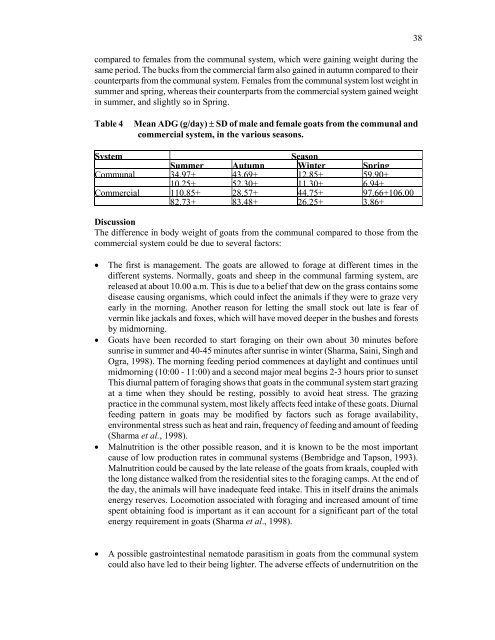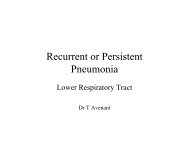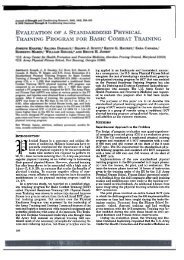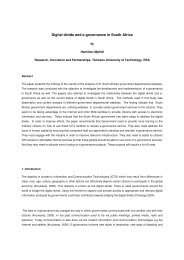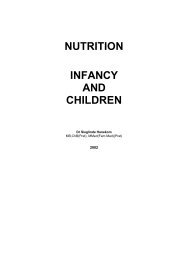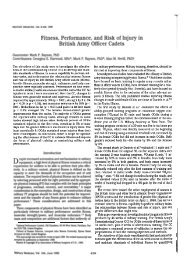Research and Training Strategies for Goat Production Systems in ...
Research and Training Strategies for Goat Production Systems in ...
Research and Training Strategies for Goat Production Systems in ...
Create successful ePaper yourself
Turn your PDF publications into a flip-book with our unique Google optimized e-Paper software.
compared to females from the communal system, which were ga<strong>in</strong><strong>in</strong>g weight dur<strong>in</strong>g the<br />
same period. The bucks from the commercial farm also ga<strong>in</strong>ed <strong>in</strong> autumn compared to their<br />
counterparts from the communal system. Females from the communal system lost weight <strong>in</strong><br />
summer <strong>and</strong> spr<strong>in</strong>g, whereas their counterparts from the commercial system ga<strong>in</strong>ed weight<br />
<strong>in</strong> summer, <strong>and</strong> slightly so <strong>in</strong> Spr<strong>in</strong>g.<br />
Table 4 Mean ADG (g/day) ± SD of male <strong>and</strong> female goats from the communal <strong>and</strong><br />
commercial system, <strong>in</strong> the various seasons.<br />
System Season<br />
Summer Autumn W<strong>in</strong>ter Spr<strong>in</strong>g<br />
Communal 34.97+ 43.69+ 12.85+ 59.90+<br />
10.25+ 52.30+ 11.30+ 6.94+<br />
Commercial 110.85+ 28.57+ 44.75+ 97.66+106.00<br />
82.73+ 83.48+ 26.25+ 3.86+<br />
Discussion<br />
The difference <strong>in</strong> body weight of goats from the communal compared to those from the<br />
commercial system could be due to several factors:<br />
• The first is management. The goats are allowed to <strong>for</strong>age at different times <strong>in</strong> the<br />
different systems. Normally, goats <strong>and</strong> sheep <strong>in</strong> the communal farm<strong>in</strong>g system, are<br />
released at about 10.00 a.m. This is due to a belief that dew on the grass conta<strong>in</strong>s some<br />
disease caus<strong>in</strong>g organisms, which could <strong>in</strong>fect the animals if they were to graze very<br />
early <strong>in</strong> the morn<strong>in</strong>g. Another reason <strong>for</strong> lett<strong>in</strong>g the small stock out late is fear of<br />
verm<strong>in</strong> like jackals <strong>and</strong> foxes, which will have moved deeper <strong>in</strong> the bushes <strong>and</strong> <strong>for</strong>ests<br />
by midmorn<strong>in</strong>g.<br />
• <strong>Goat</strong>s have been recorded to start <strong>for</strong>ag<strong>in</strong>g on their own about 30 m<strong>in</strong>utes be<strong>for</strong>e<br />
sunrise <strong>in</strong> summer <strong>and</strong> 40-45 m<strong>in</strong>utes after sunrise <strong>in</strong> w<strong>in</strong>ter (Sharma, Sa<strong>in</strong>i, S<strong>in</strong>gh <strong>and</strong><br />
Ogra, 1998). The morn<strong>in</strong>g feed<strong>in</strong>g period commences at daylight <strong>and</strong> cont<strong>in</strong>ues until<br />
midmorn<strong>in</strong>g (10:00 - 11:00) <strong>and</strong> a second major meal beg<strong>in</strong>s 2-3 hours prior to sunset<br />
This diurnal pattern of <strong>for</strong>ag<strong>in</strong>g shows that goats <strong>in</strong> the communal system start graz<strong>in</strong>g<br />
at a time when they should be rest<strong>in</strong>g, possibly to avoid heat stress. The graz<strong>in</strong>g<br />
practice <strong>in</strong> the communal system, most likely affects feed <strong>in</strong>take of these goats. Diurnal<br />
feed<strong>in</strong>g pattern <strong>in</strong> goats may be modified by factors such as <strong>for</strong>age availability,<br />
environmental stress such as heat <strong>and</strong> ra<strong>in</strong>, frequency of feed<strong>in</strong>g <strong>and</strong> amount of feed<strong>in</strong>g<br />
(Sharma et al., 1998).<br />
• Malnutrition is the other possible reason, <strong>and</strong> it is known to be the most important<br />
cause of low production rates <strong>in</strong> communal systems (Bembridge <strong>and</strong> Tapson, 1993).<br />
Malnutrition could be caused by the late release of the goats from kraals, coupled with<br />
the long distance walked from the residential sites to the <strong>for</strong>ag<strong>in</strong>g camps. At the end of<br />
the day, the animals will have <strong>in</strong>adequate feed <strong>in</strong>take. This <strong>in</strong> itself dra<strong>in</strong>s the animals<br />
energy reserves. Locomotion associated with <strong>for</strong>ag<strong>in</strong>g <strong>and</strong> <strong>in</strong>creased amount of time<br />
spent obta<strong>in</strong><strong>in</strong>g food is important as it can account <strong>for</strong> a significant part of the total<br />
energy requirement <strong>in</strong> goats (Sharma et al., 1998).<br />
• A possible gastro<strong>in</strong>test<strong>in</strong>al nematode parasitism <strong>in</strong> goats from the communal system<br />
could also have led to their be<strong>in</strong>g lighter. The adverse effects of undernutrition on the<br />
38


